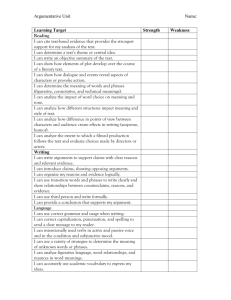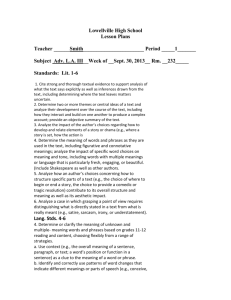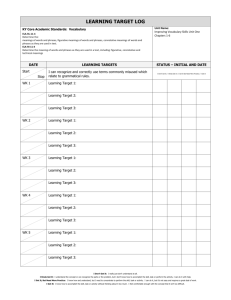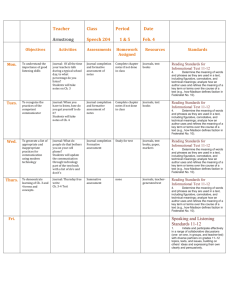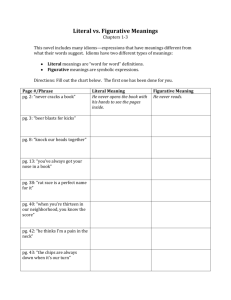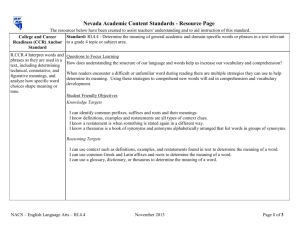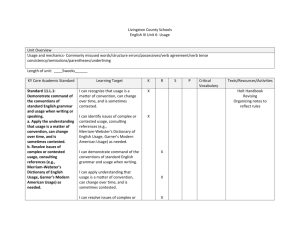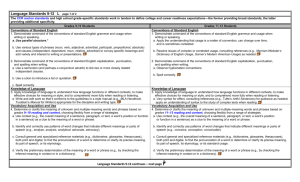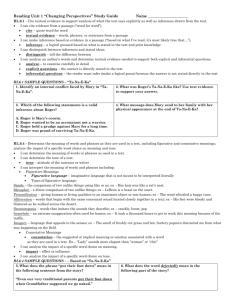Vocabulary Standards Handout - Oregon Department of Education
advertisement
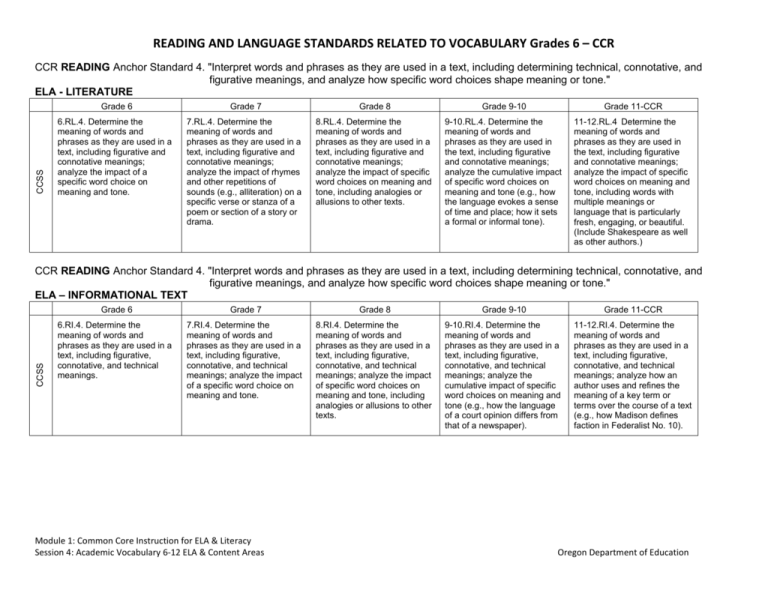
READING AND LANGUAGE STANDARDS RELATED TO VOCABULARY Grades 6 – CCR CCSS CCR READING Anchor Standard 4. "Interpret words and phrases as they are used in a text, including determining technical, connotative, and figurative meanings, and analyze how specific word choices shape meaning or tone." ELA - LITERATURE Grade 6 Grade 7 Grade 8 Grade 9-10 Grade 11-CCR 6.RL.4. Determine the meaning of words and phrases as they are used in a text, including figurative and connotative meanings; analyze the impact of a specific word choice on meaning and tone. 7.RL.4. Determine the meaning of words and phrases as they are used in a text, including figurative and connotative meanings; analyze the impact of rhymes and other repetitions of sounds (e.g., alliteration) on a specific verse or stanza of a poem or section of a story or drama. 8.RL.4. Determine the meaning of words and phrases as they are used in a text, including figurative and connotative meanings; analyze the impact of specific word choices on meaning and tone, including analogies or allusions to other texts. 9-10.RL.4. Determine the meaning of words and phrases as they are used in the text, including figurative and connotative meanings; analyze the cumulative impact of specific word choices on meaning and tone (e.g., how the language evokes a sense of time and place; how it sets a formal or informal tone). 11-12.RL.4 Determine the meaning of words and phrases as they are used in the text, including figurative and connotative meanings; analyze the impact of specific word choices on meaning and tone, including words with multiple meanings or language that is particularly fresh, engaging, or beautiful. (Include Shakespeare as well as other authors.) CCSS CCR READING Anchor Standard 4. "Interpret words and phrases as they are used in a text, including determining technical, connotative, and figurative meanings, and analyze how specific word choices shape meaning or tone." ELA – INFORMATIONAL TEXT Grade 6 Grade 7 Grade 8 Grade 9-10 Grade 11-CCR 6.RI.4. Determine the meaning of words and phrases as they are used in a text, including figurative, connotative, and technical meanings. 7.RI.4. Determine the meaning of words and phrases as they are used in a text, including figurative, connotative, and technical meanings; analyze the impact of a specific word choice on meaning and tone. 8.RI.4. Determine the meaning of words and phrases as they are used in a text, including figurative, connotative, and technical meanings; analyze the impact of specific word choices on meaning and tone, including analogies or allusions to other texts. 9-10.RI.4. Determine the meaning of words and phrases as they are used in a text, including figurative, connotative, and technical meanings; analyze the cumulative impact of specific word choices on meaning and tone (e.g., how the language of a court opinion differs from that of a newspaper). 11-12.RI.4. Determine the meaning of words and phrases as they are used in a text, including figurative, connotative, and technical meanings; analyze how an author uses and refines the meaning of a key term or terms over the course of a text (e.g., how Madison defines faction in Federalist No. 10). Module 1: Common Core Instruction for ELA & Literacy Session 4: Academic Vocabulary 6-12 ELA & Content Areas Oregon Department of Education READING AND LANGUAGE STANDARDS RELATED TO VOCABULARY Grades 6 – CCR CCSS CCR LANGUAGE Anchor Standard 4. "Determine or clarify the meaning of unknown and multiple-meaning words and phrases by using context clues, analyzing meaningful word parts, and consulting general and specialized reference materials, as appropriate." Grade 6 4. Determine or clarify the meaning of unknown and multiple-meaning words and phrases based on grade 6 reading and content, choosing flexibly from a range of strategies. a. Use context (e.g., the overall meaning of a sentence or paragraph; a word’s position or function in a sentence) as a clue to the meaning of a word or phrase. b. Use common, gradeappropriate Greek or Latin affixes and roots as clues to the meaning of a word (e.g., audience, auditory, audible). c. Consult reference materials (e.g., dictionaries, glossaries, thesauruses), both print and digital, to find the pronunciation of a word or determine or clarify its precise meaning or its part of speech. d. Verify the preliminary determination of the meaning of a word or phrase (e.g., by checking the inferred meaning in context or in a dictionary). Grade 7 4. Determine or clarify the meaning of unknown and multiple-meaning words and phrases based on grade 7 reading and content, choosing flexibly from a range of strategies. a. Use context (e.g., the overall meaning of a sentence or paragraph; a word’s position or function in a sentence) as a clue to the meaning of a word or phrase. b. Use common, gradeappropriate Greek or Latin affixes and roots as clues to the meaning of a word (e.g., belligerent, bellicose, rebel). c. Consult general and specialized reference materials (e.g., dictionaries, glossaries, thesauruses), both print and digital, to find the pronunciation of a word or determine or clarify its precise meaning or its part of speech. d. Verify the preliminary determination of the meaning of a word or phrase (e.g., by checking the inferred meaning in context or in a dictionary). Module 1: Common Core Instruction for ELA & Literacy Session 4: Academic Vocabulary 6-12 ELA & Content Areas Grade 8 4. Determine or clarify the meaning of unknown and multiple-meaning words or phrases based on grade 8 reading and content, choosing flexibly from a range of strategies. a. Use context (e.g., the overall meaning of a sentence or paragraph; a word’s position or function in a sentence) as a clue to the meaning of a word or phrase. b. Use common, gradeappropriate Greek or Latin affixes and roots as clues to the meaning of a word (e.g., precede, recede, secede). c. Consult general and specialized reference materials (e.g., dictionaries, glossaries, thesauruses), both print and digital, to find the pronunciation of a word or determine or clarify its precise meaning or its part of speech. d. Verify the preliminary determination of the meaning of a word or phrase (e.g., by checking the inferred meaning in context or in a dictionary). Grade 9-10 4. Determine or clarify the meaning of unknown and multiple-meaning words and phrases based on grades 9–10 reading and content, choosing flexibly from a range of strategies. a. Use context (e.g., the overall meaning of a sentence, paragraph, or text; a word’s position or function in a sentence) as a clue to the meaning of a word or phrase. b. Identify and correctly use patterns of word changes that indicate different meanings or parts of speech (e.g., analyze, analysis, analytical; advocate, advocacy). c. Consult general and specialized reference materials (e.g., dictionaries, glossaries, thesauruses), both print and digital, to find the pronunciation of a word or determine or clarify its precise meaning, its part of speech, or its etymology. d. Verify the preliminary determination of the meaning of a word or phrase (e.g., by checking the inferred meaning in context or in a dictionary). Grade 11-CCR 4. Determine or clarify the meaning of unknown and multiple-meaning words and phrases based on grades 11–12 reading and content, choosing flexibly from a range of strategies. a. Use context (e.g., the overall meaning of a sentence, paragraph, or text; a word’s position or function in a sentence) as a clue to the meaning of a word or phrase. b. Identify and correctly use patterns of word changes that indicate different meanings or parts of speech (e.g., conceive, conception, conceivable). c. Consult general and specialized reference materials (e.g., dictionaries, glossaries, thesauruses), both print and digital, to find the pronunciation of a word or determine or clarify its precise meaning, its part of speech, its etymology, or its standard usage. d. Verify the preliminary determination of the meaning of a word or phrase (e.g., by checking the inferred meaning in context or in a dictionary). Oregon Department of Education READING AND LANGUAGE STANDARDS RELATED TO VOCABULARY Grades 6 – CCR CCSS CCR LANGUAGE Anchor Standard 5: "Demonstrate understanding of figurative language, word relationships, and nuances in word meanings." Grade 6 6.L.5. Demonstrate understanding of figurative language, word relationships, and nuances in word meanings. a. Interpret figures of speech (e.g., personification) in context. b. Use the relationship between particular words (e.g., cause/effect, part/whole, item/category) to better understand each of the words. c. Distinguish among the connotations (associations) of words with similar denotations (definitions) (e.g., stingy, scrimping, economical, unwasteful, thrifty). Grade 7 7.L.5. Demonstrate understanding of figurative language, word relationships, and nuances in word meanings. a. Interpret figures of speech (e.g., literary, biblical, and mythological allusions) in context. b. Use the relationship between particular words (e.g., synonym/antonym, analogy) to better understand each of the words. c. Distinguish among the connotations (associations) of words with similar denotations (definitions) (e.g., refined, respectful, polite, diplomatic, condescending). Module 1: Common Core Instruction for ELA & Literacy Session 4: Academic Vocabulary 6-12 ELA & Content Areas Grade 8 8.L.5. Demonstrate understanding of figurative language, word relationships, and nuances in word meanings. a. Interpret figures of speech (e.g. verbal irony, puns) in context. b. Use the relationship between particular words to better understand each of the words. c. Distinguish among the connotations (associations) of words with similar denotations (definitions) (e.g., bullheaded, willful, firm, persistent, resolute). Grade 9-10 9-10.L.5. Demonstrate understanding of figurative language, word relationships, and nuances in word meanings. a. Interpret figures of speech (e.g., euphemism, oxymoron) in context and analyze their role in the text. b. Analyze nuances in the meaning of words with similar denotations. Grade 11-CCR 11-12.L.5. Demonstrate understanding of figurative language, word relationships, and nuances in word meanings. a. Interpret figures of speech (e.g., hyperbole, paradox) in context and analyze their role in the text. b. Analyze nuances in the meaning of words with similar denotations. Oregon Department of Education READING AND LANGUAGE STANDARDS RELATED TO VOCABULARY Grades 6 – CCR CCR LANGUAGE Anchor Standard 6: "Acquire and use accurately a range of general academic and domain-specific words and phrases sufficient for reading, writing, speaking, and listening at the college and career readiness level; demonstrate independence in gathering vocabulary knowledge when considering a word or phrase important to CCSS comprehension or expression." Grade 6 6.L.6. Acquire and use accurately gradeappropriate general academic and domainspecific words and phrases; gather vocabulary knowledge when considering a word or phrase important to comprehension or expression. Grade 7 7.L.6. Acquire and use accurately gradeappropriate general academic and domainspecific words and phrases; gather vocabulary knowledge when considering a word or phrase important to comprehension or expression. Module 1: Common Core Instruction for ELA & Literacy Session 4: Academic Vocabulary 6-12 ELA & Content Areas Grade 8 8.L.6. Acquire and use accurately gradeappropriate general academic and domainspecific words and phrases; gather vocabulary knowledge when considering a word or phrase important to comprehension or expression. Grade 9-10 9-10.L.6. Acquire and use accurately general academic and domainspecific words and phrases, sufficient for reading, writing, speaking, and listening at the college and career readiness level; demonstrate independence in gathering vocabulary knowledge when considering a word or phrase important to comprehension or expression. Grade 11-CCR 11-12.L.6. Acquire and use accurately general academic and domainspecific words and phrases, sufficient for reading, writing, speaking, and listening at the college and career readiness level; demonstrate independence in gathering vocabulary knowledge when considering a word or phrase important to comprehension or expression. Oregon Department of Education
